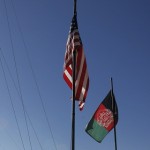A few weeks after 9/11, the U.S. government launched Operation Enduring Freedom, declaring war on the Al-Qaeda. U.S. troops barged into Afghanistan and forced the Al-Qaeda and the then ruling Taliban government out of Kabul in a couple of months. Taking charge of Afghanistan’s administration, it recalibrated its strategy from combating terrorism to rebuilding the nation’s capacity.
The reconstruction of Afghanistan’s broken ring road, which was first done by the Soviet Union in the 1960s, was among the U.S.’ most important rebuilding initiatives in Afghanistan. Yet, today, it is in a shambles – just the way the U.S. had found it in 2001 when they began. The only semi-functioning patch of this ring road between Kabul and Kandahar has now become the lifeline of the Afghanistan government, enabling most of the country’s trade and transportation, while the rest of it has fallen to the Taliban’s control. It has become a symbol of how the U.S.’ well-intentioned efforts have not borne results because of commitment to the project faltering.
The 3,200-km ring road connects Afghanistan’s four main cities: Kabul, Kandahar, Herat and Mazar-i-Sharif. Major countries and banks had pledged $1.5 billion to the ring road project in 2003 and it showed progress[1] until the U.S. invaded Iraq soon after. Most resources were diverted to Iraq and Afghanistan’s project began to stall. Funding for the ring road project was cut by $1.2 billion by 2006 and the Taliban seized this opportunity to regroup and retaliate. Drew Conway, then a political science student, plotted[2] the Wikileaks’ Afghanistan war logs[3] between 2004 and 2009 on a map that showed how insurgent attacks mushroomed around the ring road, especially on the Kabul-Kandahar highway.
By 2009, the Taliban had reclaimed a significant portion of its lost territory in the south and east. Barack Obama in 2009 accepted that the Taliban “[h]ad gained momentum” but posed “[n]o imminent threat of the [Afghanistan] government being overthrown”[4]. He sent in over 70,000 U.S. troops[5] , but the Taliban had regained enough momentum to fight them, making highway reconstruction nearly impossible.
Observing the U.S.’ casualties and increased construction costs a year and a half later, Barack Obama started to pull the troops out of Afghanistan.[6] As the strategy changed from “combat to support”, Afghanistan’s reconstruction became a lost cause, and remained so also after Donald Trump became President.
“We are not nation-building again,” Trump said in 2017, referring to the ring road reconstruction and other incipient capacity-building projects.[7]
The exit of the U.S. is one aspect of the crippling of Afghanistan. The Special Inspector General for Afghanistan Reconstruction had said in his October 2016 audit report that the Kabul-Kandahar highway was “beyond repair” and it would cost $8.3 billion to replace it.[8] Afghanistan’s Ministry of Public Works’ outlook was grimmer when it noted that were the Kabul-Kandahar highway to become impassable, its central government may also collapse.[9]
The Afghanistan government is known for widespread corruption[10] in its administration, which, combined with the U.S.’ departure, only makes matters worse for Afghan citizens. An administrative collapse can also have repercussions outside Afghanistan, both in terms of reduced regional security and trade disruptions.
The U.S.’ intention to rebuild may have been genuine enough, but the ring road clearly lacked proper execution. The cost of such laggardliness is being borne by those who aligned with the U.S., and Afghan citizens, who are now paying with their lives.
The Taliban has once again grown strong enough to disrupt society through the use of ammunition and may soon avenge a weakening government. Such a situation could have been averted had the international community stuck to its agenda and maintained its focus on stabilising Afghanistan. Their half-hearted efforts have only led to wasted resources and opportunities. The leaders of today cannot afford to let the Taliban snatch what does not belong to them.
Vihang Jumle is an Associate at Ikigai Law
This blog was exclusively written for Gateway House: Indian Council on Global Relations. You can read more exclusive content here.
For interview requests with the author, or for permission to republish, please contact outreach@gatewayhouse.in
© Copyright 2019 Gateway House: Indian Council on Global Relations. All rights reserved. Any unauthorized copying or reproduction is strictly prohibited.
References
[1] United States Agency for International Development, ‘Rebuilding Afghanistan; Road to Success’, USAID, 2003, https://www.hsdl.org/?view&did=446323
[2] Conway, Drew, “Animated Heatmap of Wikileaks Report intensity in Afghanistan”, drewconway.com, 17 August 2010, http://drewconway.com/zia/2013/3/27/animated-heatmap-of-wikileaks-report-intensity-in-afghanistan
[3] Wikileaks, “Afghan War Diary, 2004-2010″, Wikileaks, 25 July 2010, https://wikileaks.org/wiki/Afghan_War_Diary,_2004-2010
[4] Obama, Barack, “December 1, 2009: Speech on Strategy in Afghanistan and Pakistan”, Miller Center, 1 Deecember 2009, https://millercenter.org/the-presidency/presidential-speeches/december-1-2009-speech-strategy-afghanistan-and-pakistan
[5] Peters, Heidi M. and Plagakis, Sofia, “Department of Defense Contractor and Troop levels in Afghanistan and Iraq: 2007- 2018″, Congressional Research Service, 10 May 2019, https://fas.org/sgp/crs/natsec/R44116.pdf
[6] Obama, Barack, “June 22, 2011: Remarks on the Afghanistan Pullout”, Miller Center, 22 June 2011, https://millercenter.org/the-presidency/presidential-speeches/june-22-2011-remarks-afghanistan-pullout
[7] President of the United States, “Remarks by President Trump on the strategy in Afghanistan and South Asia”, White House, 21 August 2017, https://www.whitehouse.gov/briefings-statements/remarks-president-trump-strategy-afghanistan-south-asia/
[8] Special Inspector General for Afghanistan Reconstruction, “Afghanistan’s Road Infrastructure: Sustainment Challenges and Lack of Repairs put U.S. Investment at Risk”, SIGAR, October 2016, https://www.sigar.mil/pdf/audits/SIGAR-17-11-AR.pdf
[9] Special Inspector General for Afghanistan Reconstruction, “Afghanistan’s Road Infrastructure: Sustainment Challenges and Lack of Repairs put U.S. Investment at Risk”, SIGAR, October 2016, https://www.sigar.mil/pdf/audits/SIGAR-17-11-AR.pdf
[10] Transparency Intertnational, “Afghnaistan”, Transparency International, https://www.transparency.org/country/AFG


